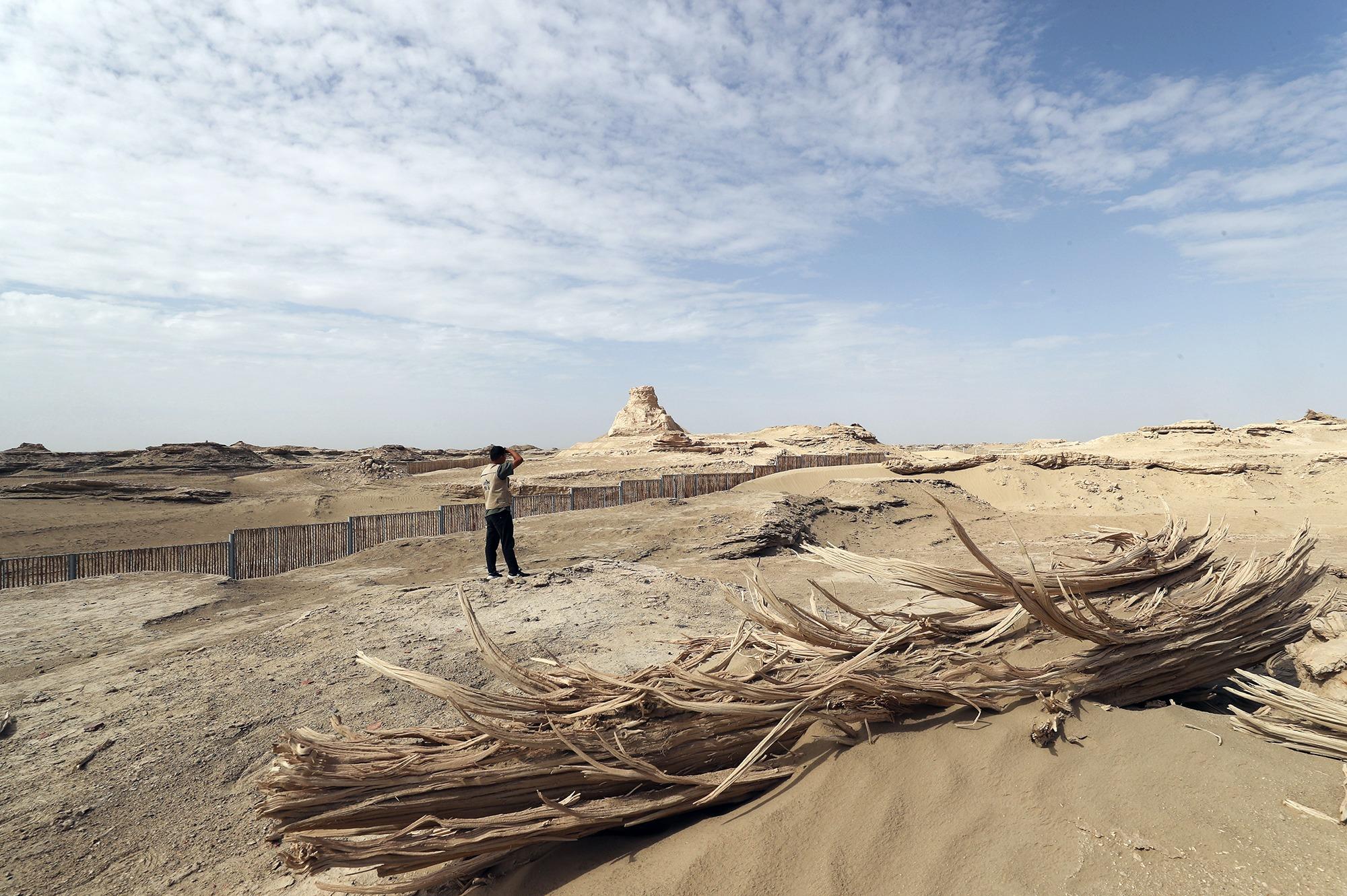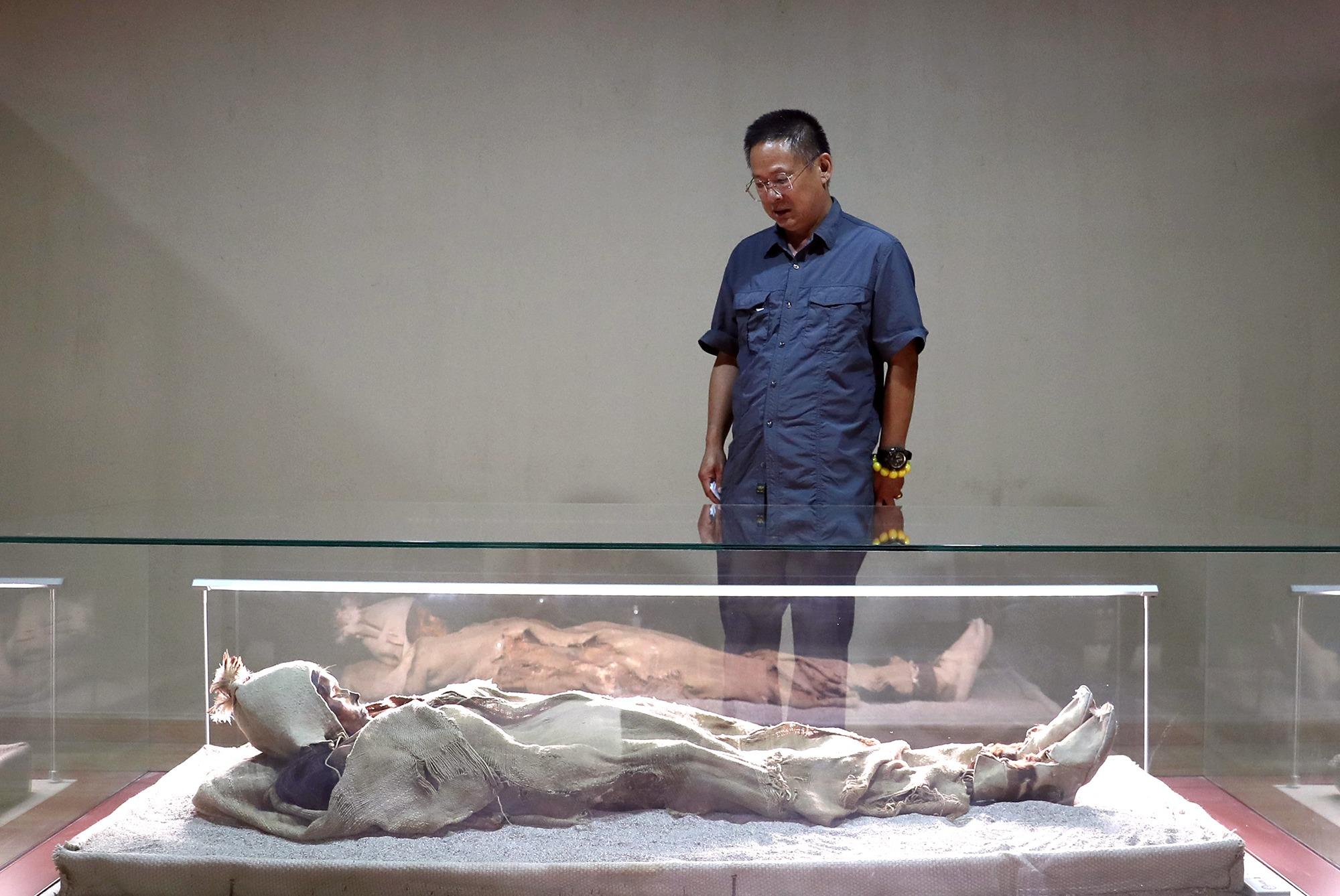 A member of the Loulan cultural relics protection station patrols the site of Loulan ancient city in the Xinjiang Uygur autonomous region in July. (ZOU HONG / CHINA DAILY)
A member of the Loulan cultural relics protection station patrols the site of Loulan ancient city in the Xinjiang Uygur autonomous region in July. (ZOU HONG / CHINA DAILY)
Even in the world today, some people still live an isolated life. Far away from crowds, with no cellphone reception or access to the internet, they are cut off from the rest of the world, left guarding time-honored cultural remains in a harsh environment.
The living conditions, however, have improved a lot compared to 25 years ago, when Jiao Yingxin, former head of the cultural heritage administration in Ruoqiang county, Bayingolin Mongol autonomous prefecture, Xinjiang Uygur autonomous region, began protecting the site of Loulan, an ancient city on the Silk Road.
Over the years, Jiao devoted himself to protecting cultural heritage in Lop Nur, the site of a former salt lake in Ruoqiang. The harsh environment, extreme solitude, and his family's misgivings did not hinder him, and his perseverance helped him build a deep bond with the places he guarded for decades.
With scorching summers, freezing winters, extreme droughts and sandstorms, few people set foot on Lop Nur, making it a famous, but unpopulated, area. However, it is home to many historical and cultural remains, since it was once a stop along the ancient Silk Road.
Historical records show that, before the 2nd century BC, Loulan was already famous in Xiyu (the western regions, a term to describe today's Xinjiang and Central Asia in ancient times), and it collapsed in about the 5th century. In 1900, Swedish explorer Sven Hedin discovered the site of Loulan, which covers an area of 120,000 square meters, according to Jiao.
ALSO READ: City slowly reveals its history
In the 1990s, with the discovery of a number of mummified corpses, many grave robbers sought to steal cultural relics. To stop these illegal activities, a Loulan cultural relics protection station was built in 1998, although at the beginning, staff lived in tents or diwozi, shelters dug into the ground and covered with a straw roof above ground level. In 2003, it was turned into a long-term station.
The main work for station staff is to patrol the area they are responsible for, stop any illegal activities they discover, and check the condition of the cultural remains. Jiao has plenty of experience in the fight against relic theft, though in recent years, it has almost disappeared. While few and far between, it is unauthorized visits from curious travelers that cause the most harm these days.
"Since the site is so big, with many historical remains, casual visits by people can be a problem," explains Jiao, who adds that Lop Nur is also dangerous for inexperienced visitors, with frequent sandstorms that can make it easy to get lost.
At first, Jiao and his colleagues completed their patrols on foot, but now motorbikes have become the main source of transportation for them.
"With just a bottle of drinking water and one nang (Xinjiang-style bread), I could walk for 70 kilometers in Lop Nur. When it was scorching and I had to rest, it was difficult to find shade from trees or plants. I had to find a yardang (a sharp-crested ridge carved by wind) and rest in its cracks," recalls Jiao.
Even today, when the road has been built, it takes six hours by car to travel from downtown Ruoqiang to the station. In the past, it took several days.
 Jiao Yingxin, former head of the Ruoqiang cultural heritage administration, looks at the Loulan Beauty, a mummy he discovered in 2004, at the Loulan Museum in Ruoqiang county in July. (ZOU HONG / CHINA DAILY)
Jiao Yingxin, former head of the Ruoqiang cultural heritage administration, looks at the Loulan Beauty, a mummy he discovered in 2004, at the Loulan Museum in Ruoqiang county in July. (ZOU HONG / CHINA DAILY)
In 2005, when floods destroyed part of the road to the station, supplies, especially water, could not get through, and Jiao and his colleagues had to drink water thickened by dust because it had been kept outdoors for a long time. Drawing from the lesson, a water cellar was built later to better keep water inside the station.
In the Loulan Museum in Ruoqiang today, visitors often marvel at a 3,800-year-old female mummy with clearly visible features, down to details like her eyebrows and eyelashes. The mummy is called the Loulan Beauty. In fact, it was Jiao and his colleagues who discovered her, completely by chance, in 2004.
They were patrolling the area, and when they sat on a high platform to have a rest, Jiao found that the earth was not very stable and that there was an object underneath. They removed the surface earth and found the mummy underneath.
They brought it back to the station, which consisted of several tents, and contacted people to come and collect it. At that time, it still took days to reach the station from downtown Ruoqiang. They wrapped the mummy in bedsheets and put it in a tent.
Feeling uncomfortable, Jiao's colleagues refused to sleep near it, but Jiao didn't mind and slept beside it for nearly a month until it was finally transported to the experts.
"I didn't feel strange at all. All I thought about was how to better protect it, fearing it would become oxidized," says Jiao.
ALSO READ: Perfection to a tea
Also in that year, Jiao found the mummified remains of a child and wrapped it in his jacket, taking it to downtown Ruoqiang by car — a journey of more than 330 kilometers. Since the road was bumpy, he held it carefully in his arms trying to protect it from being damaged.
In the following years, conditions at the protection station continued to improve. Houses were gradually built, while electricity and a TV set were installed. Moreover, staff at the station started to raise dogs and chickens to add color to their lives.
"The living conditions have improved significantly, although compared with places outside Lop Nur, it's still far from perfect," says Jiao.
That may explain why it's so difficult to keep people at the stations. Some could only tolerate staying for a few days, before leaving.
"It's a matter of personal choice. When I took the job, I found it amazing, since I'm interested in history. The more I understood Loulan and its history, the more I wanted to continue learning. When you really have an interest in your job, it doesn't feel like torture," says Jiao.
According to Feng Jing, director of the Loulan Museum, study of the Loulan site started in 1979. Since 1988, several projects to protect cultural relics have been carried out in the area, but no major archaeological excavations have taken place yet.
ALSO READ:Chinese writers shine at world's prestigious sci-fi awards
"In the year before last (2021), when we cleaned and consolidated the pagoda and sanjianfang (remains of a structure believed to be a government office) at the Loulan site, we discovered many cultural relics, like manuscripts. Therefore, we believe a systematic excavation will bring more important discoveries," says Jiao.
"But before that, we must properly protect them. It's not only about our respect for our ancestors, but also our responsibility to our offspring. If the remains are destroyed in our time, we will feel guilty," he adds.
Over the years, five stations of this type have been built in Lop Nur, and altogether employ 20 people to safeguard heritage, according to Feng.
Jiao retired two years ago, but he often wants to revisit Lop Nur. "From the establishment of the Loulan station until today, I experienced so many things there. It became my home in some ways. I do have a deep emotional connection with the place," he says.
Zhang Xiao contributed to this story.


